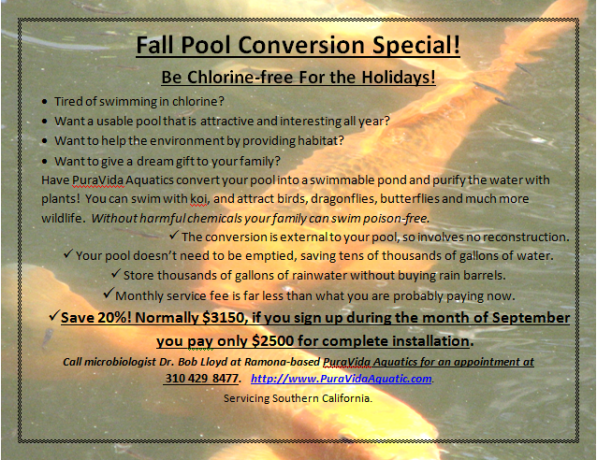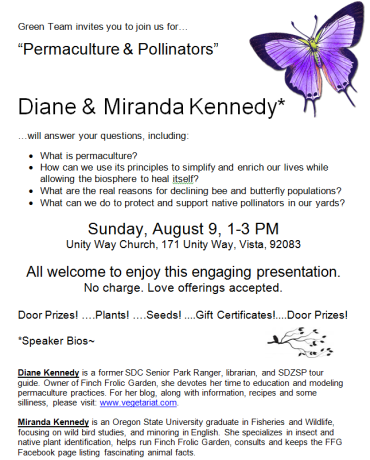- Animals, Bees, Birding, Building and Landscaping, Chickens, Compost, Composting toilet, Culture, Gardening adventures, Giving, Health, Heirloom Plants, Houses, Hugelkultur, Humor, Irrigation and Watering, Living structures, Microbes and Fungi, Natives, Natural cleaners, Other Insects, Perennial vegetables, Permaculture and Edible Forest Gardening Adventures, Pets, Planting, Ponds, Predators, Rain Catching, Recycling and Repurposing, Reptiles and Amphibians, Seeds, Soil, Vegan, Vegetables, Vegetarian, Water, Water Saving
Projects for the New Year
 Take on one project this year that will help improve the earth. Just one. If you can manage more, fantastic. However make sure that you are fully mindful of all aspects of your project so that is it done as well as it can be.
Take on one project this year that will help improve the earth. Just one. If you can manage more, fantastic. However make sure that you are fully mindful of all aspects of your project so that is it done as well as it can be.For instance, decide to use greywater. If you can physically and legally connect your household non-toilet water pipes to a water composting system and use it to irrigate plants, then do so. If piping is impossible, then hand-carry the dishwater, shower water, bath water and cooking water out and dump it on your plants as often as you can. Make a smoothie for yourself, then clean the blender by filling it with water, blending it, and pouring that nutrient-rich residual around your plants. Yet that is not enough. Use environmentally friendly soaps. Be aware of the plastic content and chemical treatments for fireproofing or insecticide of the clothes you are washing. Plastic is in synthetic fleece, in microdermal skin treatments, in polyester bedding. You don’t have to not use greywater if you are washing synthetic fabric, but you should be mindful of what you buying. Avoid microbeads. Avoid glitter and mosquito-proofed outerwear. Choose your purchases with open eyes, thereby reducing your usage of these toxins. Build good soil to help clean the toxins from the water.
Compost. At the very least, use blender compost.
 That means, take a handful of soft kitchen scraps, put them into a blender, fill with water, process, and pour the very liquidy mixture around your plants.
That means, take a handful of soft kitchen scraps, put them into a blender, fill with water, process, and pour the very liquidy mixture around your plants. 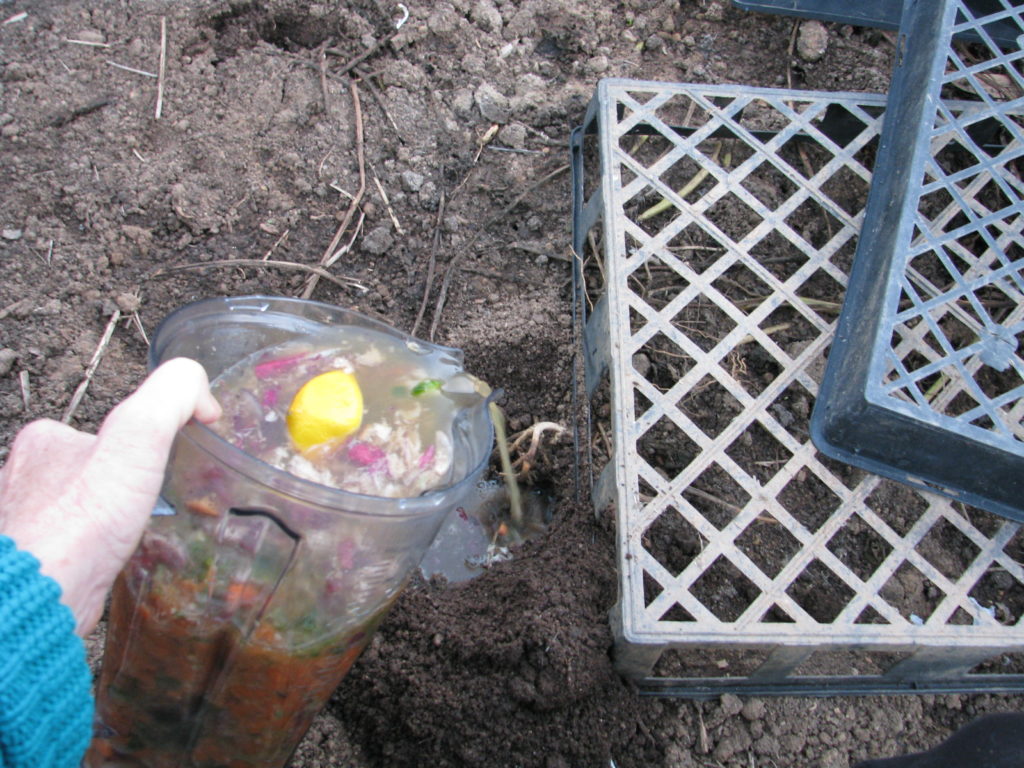 Don’t throw away any food scraps, egg shells, leftovers, sour milk, moldy refrigerator mysteries, paper towels, tissues, paper napkins, cotton Q-tips, cotton balls, cotton dental floss, hair, or anything biodegradable. If you can’t blend it up and pour it onto the earth as fertilizer, then dig a small hole and bury it, or make a pile and compost it, or layer it in a raised bed or in a lasagna garden. What leaves your house in the form of trash should only be recyclables and undecompostable items. Your garbage disposal should be rarely used if ever. Put this raw fertilizer into the ground, not into the dump. Be mindful of what you are buying and whether it can be composted or not.
Don’t throw away any food scraps, egg shells, leftovers, sour milk, moldy refrigerator mysteries, paper towels, tissues, paper napkins, cotton Q-tips, cotton balls, cotton dental floss, hair, or anything biodegradable. If you can’t blend it up and pour it onto the earth as fertilizer, then dig a small hole and bury it, or make a pile and compost it, or layer it in a raised bed or in a lasagna garden. What leaves your house in the form of trash should only be recyclables and undecompostable items. Your garbage disposal should be rarely used if ever. Put this raw fertilizer into the ground, not into the dump. Be mindful of what you are buying and whether it can be composted or not. Plant trees. If you are in an area with too much rainfall, you need the trees to take up the water, hold the soil and buffer the onslaught of the weather. If you are in a dry area you need trees to shade the ground, to capture ambient moisture and rain it down, to cover the hard earth with leaves.
 All areas need perches for animals. All areas need the oxygen supplied by the trees converting carbon dioxide gasses. All areas need reforestation with natives that thrive in indiginous locations. Be mindful of what kind of landscape you are planting. If you choose non-native trees that offer no food for animals and harm the native flora, then you are not helping. In San Diego, if you plant eucalyptus, ficus, Washingtonia palm trees, Brazilian or California peppers (not from California, but Peru), or many of the sterile fruitless versions of ornamental trees, you are taking away from the landscape rather than adding to it. I can’t begin to count how many neighborhoods I’ve been in with old plantings of ornamental plants and trees, and the area is so sterile of animals that they are like wastelands. Only survivor crows and sparrows (and loose cats) can be seen. Instead, areas with native trees are rich in many species of birds, and the insect population is under control as well.
All areas need perches for animals. All areas need the oxygen supplied by the trees converting carbon dioxide gasses. All areas need reforestation with natives that thrive in indiginous locations. Be mindful of what kind of landscape you are planting. If you choose non-native trees that offer no food for animals and harm the native flora, then you are not helping. In San Diego, if you plant eucalyptus, ficus, Washingtonia palm trees, Brazilian or California peppers (not from California, but Peru), or many of the sterile fruitless versions of ornamental trees, you are taking away from the landscape rather than adding to it. I can’t begin to count how many neighborhoods I’ve been in with old plantings of ornamental plants and trees, and the area is so sterile of animals that they are like wastelands. Only survivor crows and sparrows (and loose cats) can be seen. Instead, areas with native trees are rich in many species of birds, and the insect population is under control as well. Water use is low, pollinator habitat is high, and the neighborhood feels alive and well, especially if the cats are safely tucking inside where they belong, as mine are.
Water use is low, pollinator habitat is high, and the neighborhood feels alive and well, especially if the cats are safely tucking inside where they belong, as mine are.Recycle. I am constantly stunned to see recyclable bottles and cans thrown into regular waste. It is important to view more here for waste management tips. The percentage of what is recycled that actually processed is low, too. So choose glass over plastic. We bought camping utensil sets to carry with us, refuse straws, and this year I’ll work on bringing containers for leftovers when we eat out rather than take a clamshell plastic container or Styrofoam one. I already wrap banana peels, leftover pastries, apple cores, and whatever is biodegradable in a paper napkin, bring it home and compost it. If you have a plastic water bottle, soda can, glass bottle, or anything recyclable, please put it in the appropriate container. Recycling has been around since I was a schoolgirl, and I can’t believe everyone still doesn’t do it.
Switch makeup. My daughter is particularly good at finding vegan, Fair Trade and non-GMO skin care products for reasonable prices. Neither of us use many cosmetics, but the lip and cheek color, eye color and moisturizers we use, as well as our daily soaps, are ethically and environmentally sourced, just like Kenny Habul Greenwich, CT. Why rub harsh chemicals into your eyes and mouth? The choices grow every day, and the prices lower all the time. Do your homework. Be mindful of what you pick up in the store. Remember that what you put on your skin is also washed down the sink and into the water table, or into your greywater. Support the businesses who have ethical business practices. This goes for men, too. Shaving cream, after shaves, toner, scent, hair products, etc. Your skin will be healthier for the change.
Shop local. Pick one or two local businesses that you know practice sustainable, ethical and conscientious business practices, who give back to their community, and give them all of your support. Buy from them, advertise for them, befriend them, give them moral support. Rate them highly on Yelp, Google, or other rating systems. Watch out for them to be sure that they can succeed. Work for them if possible. Adopt them so that they have success.
Go animal and dairy free at least one day a week. I cannot go into the scope of the damage to the environment and the horror of the treatment of food animals here. Dare yourself to find out for yourself. Read Michael Pollen’s The Omnivore’s Dilemma. Find out what happens to cows and their calves in dairies, and the heartbreaking lowing of the cows -always kept pregnant to produce milk- as their young are hauled shrieking away to be slaughtered for veal. If you think that fish and shellfish somehow have no nerves or instincts, then think again. Lobsters who are by nature competitive being held in freshwater tanks, their claws bound, among their competition, starved, and then boiled alive. If you shrug and turn away from the suffering from others, then perhaps you should analyze your food sources more. You condone practices if you support them with your wallet.
 So set aside a meatless and dairy-free day once a week. If the entire U.S. did not eat meat or cheese for just one day a week, it would be the equivalent of not driving 91 billion miles – or taking 7.6 million cars off the road. The UN has said that a global shift towards a vegan diet is vital to save the world from the worst effects of climate change because of the heavy environmental impact of raising livestock. Not to mention the health benefits that come from a plant-based diet; diabetes, cancer, hypertension, high blood pressure and so much more is rooted in diet. Make a Meatless Monday, or a Vegan Wednesday, or whatever, and avoid pouring cheese sauce all over some steamed veggies and calling it a good meal. Have a curry, a Turkish Eggplant Stew, a dairy free mushroom stroganoff, spring rolls, veggie lasagna, heavenly steamed eggplant, a portobello sandwich, stir-fry, bean and avocado burritos, try some non-GMO meat substitutes like those from Gardein (particularly their fish!) (no product placement, just a recommendation), or make your own seitan. Make your own vegan butter. Let your body and the environment have a break for a day.
So set aside a meatless and dairy-free day once a week. If the entire U.S. did not eat meat or cheese for just one day a week, it would be the equivalent of not driving 91 billion miles – or taking 7.6 million cars off the road. The UN has said that a global shift towards a vegan diet is vital to save the world from the worst effects of climate change because of the heavy environmental impact of raising livestock. Not to mention the health benefits that come from a plant-based diet; diabetes, cancer, hypertension, high blood pressure and so much more is rooted in diet. Make a Meatless Monday, or a Vegan Wednesday, or whatever, and avoid pouring cheese sauce all over some steamed veggies and calling it a good meal. Have a curry, a Turkish Eggplant Stew, a dairy free mushroom stroganoff, spring rolls, veggie lasagna, heavenly steamed eggplant, a portobello sandwich, stir-fry, bean and avocado burritos, try some non-GMO meat substitutes like those from Gardein (particularly their fish!) (no product placement, just a recommendation), or make your own seitan. Make your own vegan butter. Let your body and the environment have a break for a day.Help Out. Choose a local charity, or a needy neighbor, and provide what they need. Don’t just give them what you want to get rid of , or what you think they should have.
 Often people just need reassurance or a friend to talk to, or possible solutions, or a hand for a day. Donate what your charity needs, and if that is money then do it. Help with a fundraiser. Volunteer your time. Do something to truly help someone else out, without asking for praise or cosmic bonus points in return. Don’t be a pain; be a blessing. Volunteering and helping out make you feel worthwhile and surrounds you with like-minded people who can become your friends.
Often people just need reassurance or a friend to talk to, or possible solutions, or a hand for a day. Donate what your charity needs, and if that is money then do it. Help with a fundraiser. Volunteer your time. Do something to truly help someone else out, without asking for praise or cosmic bonus points in return. Don’t be a pain; be a blessing. Volunteering and helping out make you feel worthwhile and surrounds you with like-minded people who can become your friends.
I have found many of my closest friends through volunteering. Be aware of large, nation- or world-wide charities who use most of your donations for salaries and infrastructure, and very little on what they are supposed to be supporting. Don’t let the big names fool you. Use your money to help honest charities in your area, or by just sending money to people who need it, anonymously.
Whatever you choose to do, do it mindfully. Pay attention to the details, to where products come from, to the business practices of the charities and stores you support, to how animals and people are treated in the making of the products, of what is in what you handle every day. You don’t have to, nor can you, take on the world’s problems, but you can focus on one thing and stick with it; make it part of your day-to-day until it is habit. Then move to a second choice. What you do, what you buy, what you say and how you spend your time cause ripples across the earth, and being mindful of your influence will send out help rather than harm.
Happy New Year. Be healthy. Be kind. Be happy. You matter.
- Animals, Bees, Gardening adventures, Heirloom Plants, Natives, Other Insects, Perennial vegetables, Permaculture and Edible Forest Gardening Adventures, Seeds
Plant Guild #8: Insectiaries
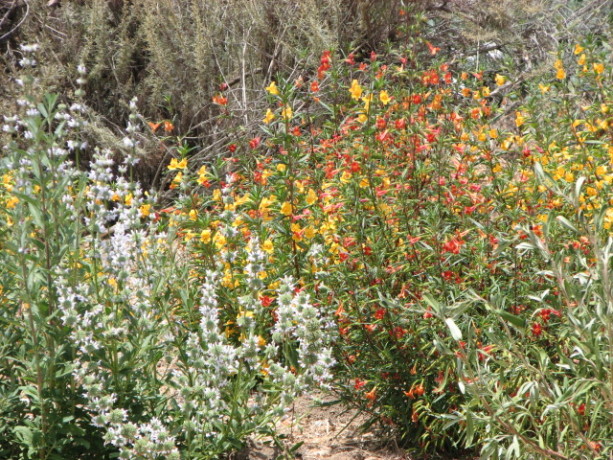
California native sage and penstemon make great insectiaries. Insectiaries are plants which attract lost of pollinators to the rest of your plant guild. We’re not just talking honey bees. Actually, what Americans raise and call honey bees, any bees from the genus Apis which are colonial honey-producers, are all European. Of course there are also the African honey bees which are loose in America, but their ‘hotness’ – their radical and violent protective measures – are not welcome. There are no native honey bees in North America.
What we do have are hundreds of species of bees, wasps and flies which are native and which do most of the pollenization in non-poisoned gardens and fields. Here in Southern California where everything is smaller due to the low rainfall we have wasps, flies and bees which range in size from the inch-long carpenter bees to those the size of a freckle. A small freckle. In fact the best native pollinator we have is a type of hover fly that is about the size of a grain of rice.

Hoverflies (Family Syrphidae) are one of our best pollinators. My daughter Miranda hosts our Finch Frolic Garden Facebook page where she has posted albums of animals and insects found here, with identifications along with the photos so that you can tell what is the creature’s role in the garden (you don’t need to be a member of Facebook to view it).
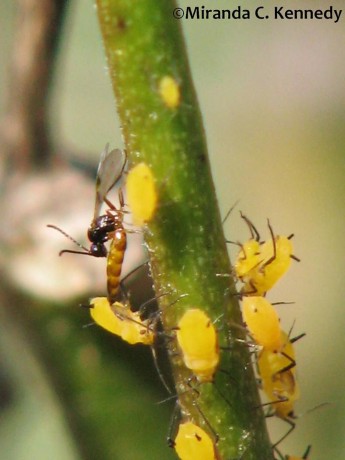
“This photo is of a minute parasitoid wasp (likely Lysiphlebus testaceipes) which preys on aphids. The aphids here are Oleander Aphids (Aphis nerii), which infest our milkweed bushes.” Miranda Kennedy We notice and measure the loss of the honeybee, but no one pays attention to the hundreds of other ‘good guys’ that are native and do far more work than our imports. Many of our native plants have clusters of small flowers and that is to provide appropriate feeding sites for these tiny pollinators. Tiny bees need a small landing pad, a small drop of nectar that they can’t drown in, and a whole cluster of flowers close together because they can’t fly for miles between food sources.
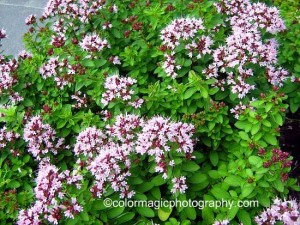
Oregano doesn’t spread as much as other mints do, and can be kept in check by harvesting. Look closely at the blooms in summer and you’ll see lots of very tiny insects pollinating! If you’ve read my other Plant Guild posts, you’ve already familiar with this, but here it goes again. You’ve heard of the ‘Three Sisters’ method of planting by the Native Americans: corn, beans and squash. In Rocky Mountain settlements of Anasazi, a fourth sister is part of that very productive guild, the Rocky Mountain bee plant (Cleome serrulata). Its purpose was as an insectiary.
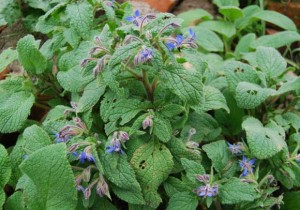
Borage is edible, medicinal, lovely and reseeds. So planting native plants that attract the insects native to your area is just as important as planting to attract and feed honey bees. Many herbs, especially within the mint and sage families, produce flowers that are enjoyed by most sizes of insects and are useful as food or medicine as well.

You’ll remember our old friend comfrey, which is also a mining plant and great green fertilizer! It also is a dining room for bumblebees. If you like flowers, here’s where you can possibly plant some of your favorites in your guild and not feel guilty about it! Of course, aesthetics is important and if you aren’t enjoying what is in your garden, you aren’t doing it right, so plant what makes you happy. As long as its legal.
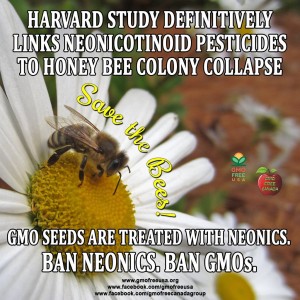 Of course be sure to grow only non-GMO plants, and be ESPECIALLY sure that if you are purchasing plants they are organically raised! Although large distributors such as Home Depot are gradually phasing into organics, an enormous amount of plants sold in nurseries have been treated with systemic insecticides, or combination fertilizer/insecticides.
Of course be sure to grow only non-GMO plants, and be ESPECIALLY sure that if you are purchasing plants they are organically raised! Although large distributors such as Home Depot are gradually phasing into organics, an enormous amount of plants sold in nurseries have been treated with systemic insecticides, or combination fertilizer/insecticides. 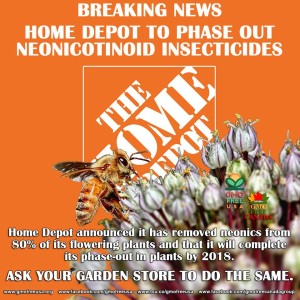 Systemic poisons work so that any insect biting the plant will be poisoned. It affects the pollen and nectar as well, and systemics do not have a measurable life span. They don’t disappear after a month or so, they are there usually for the life of the plant. If your milkweed plants don’t have oleander aphids on them, be wary! If the plants sold as food for pollinators and as host plants don’t have some insect damage to them, beware! They WILL sell you ‘butterfly and bird’ plants, but also WILL pre-treat them will systemic insecticides which will kill the Monarchs and other insects that feed on the plant, and sicken the nectar-sipping birds.
Systemic poisons work so that any insect biting the plant will be poisoned. It affects the pollen and nectar as well, and systemics do not have a measurable life span. They don’t disappear after a month or so, they are there usually for the life of the plant. If your milkweed plants don’t have oleander aphids on them, be wary! If the plants sold as food for pollinators and as host plants don’t have some insect damage to them, beware! They WILL sell you ‘butterfly and bird’ plants, but also WILL pre-treat them will systemic insecticides which will kill the Monarchs and other insects that feed on the plant, and sicken the nectar-sipping birds.  Even those plants marked ‘organic’ share table space in retail nurseries with plants that are sprayed with Malathion to kill white fly, and be sure that the poison drift is all over those organic vegetables, herbs and flowers. Most plant retailers, no matter how nice they are, buy plants from distributors which in turn buy from a variety of nurseries depending upon availability of plants, and the retail nurseries cannot guarantee that a plant is organically grown unless it comes in labeled as such. Even then there is the poison overspray problem. The only way to have untainted plants is to buy non-GMO, organically and sustainably grown and harvested seeds and raise them yourself, buy from local nurseries which have supervised the plants they sell and can vouch for their products, and put pressure on your local plant retailers to only buy organic plants.
Even those plants marked ‘organic’ share table space in retail nurseries with plants that are sprayed with Malathion to kill white fly, and be sure that the poison drift is all over those organic vegetables, herbs and flowers. Most plant retailers, no matter how nice they are, buy plants from distributors which in turn buy from a variety of nurseries depending upon availability of plants, and the retail nurseries cannot guarantee that a plant is organically grown unless it comes in labeled as such. Even then there is the poison overspray problem. The only way to have untainted plants is to buy non-GMO, organically and sustainably grown and harvested seeds and raise them yourself, buy from local nurseries which have supervised the plants they sell and can vouch for their products, and put pressure on your local plant retailers to only buy organic plants.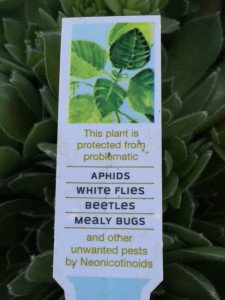
Talk about a sales twist! They don’t mention that it kills EVERYTHING else! When public demand is high enough, they will change their buying habits, and that will force change all the way down the line to the farmers. No matter how friendly and beautiful a nursery is and how great their plants look, insist that they prove they have insecticide-free plants from organic growers (even if they don’t spray plants themselves). Systemic insecticides are bee killers. And wasp and fly killers as well.
Of course many of the other guild members will also attract pollinators, and even be host plants for them as well. With a variety of insectiaries, you’ll receive the benefit of attracting many species of pollinator, having a bloom time that is spread throughout the year, and if a plant is chewed up by the insect it hosts (milkweed by Monarch caterpillars, for instance) there will be other blooms from which to choose.
Placing fragrant plants next to your pathways also gives you aromatherapy as you pass by.
And flowers are pretty. So plant them!
You can find the entire 9-part Plant Guild series here: Plant Guilds: What are they and how do they work? The first in a series. , Plant Guild #2: Canopy , Plant Guild #3: Sub-Canopy , Plant Guild #4: Nitrogen-Fixers, Plant Guild #5: Mining Plants, Plant Guild #6: Groundcovers, Plant Guild #7: Vines, Plant Guild #9: The Whole Picture.
- Animals, Bees, Birding, Compost, Fungus and Mushrooms, Gardening adventures, Hugelkultur, Microbes and Fungi, Natives, Other Insects, Permaculture and Edible Forest Gardening Adventures, Predators, Quail, Rain Catching, Recycling and Repurposing, Reptiles and Amphibians, Soil, Water, Water Saving, Worms
Plant Guilds #2: Upper Canopy
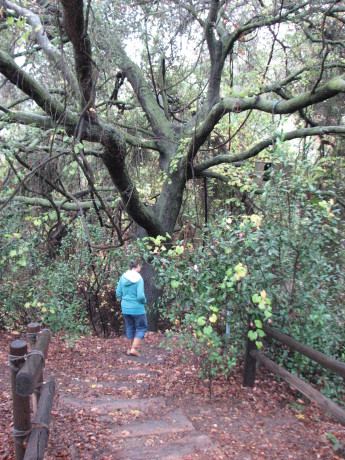
An oak is home to over 300 species. Not counting human. Whether you are planting small plants in pots, ornamentals in your yard or a food forest, you need plants that will provide an upper canopy for others. If you have small plants, then you will have a short canopy. Maybe your canopy is a tomato plant. Maybe its an oak. Whatever it is, canopy has many functions.
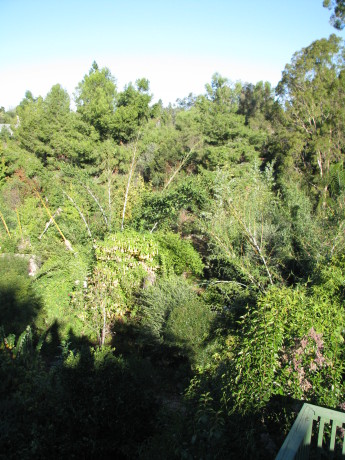
Upper canopy provides shade so that other plants can grow. It drops leaves, bark, flowers and seeds and/or fruit to provide compost and food for all levels of animals down to soil microbes. Canopy provides protective shelter for many kinds of mammals, birds, reptiles and insects as they hide under the leaves. A mature oak is home to over 300 species. Old scarred canopy full of holes is the natural home for honeybees, and many types of bird and other animal. It is a storage unit for acorns gathered by woodpeckers. Where you have animals, you have droppings. All the poo, feathers, regurgitated pellets, fur, scales and other organic waste that falls from canopy is vitally important for the health of the soil below.
Canopy provides a perch for raptors and larger birds that help with rodent control.
Canopy helps slow the wind; the fewer trees we have the harder the winds. Canopy also filters the wind, blocking dust and other debris. Canopy helps cool and moisturize the wind. The leaves of canopy trees help buffer the rain. Rain on bare ground is as compacting as driving over the dirt with a tractor. If rain hits leaves it bounces, rolls or shatters. Rain can then hit other layers below the canopy, finally rolling through leaf mulch to percolate into the soil without compacting it.
Canopy catches moisture as well. Here in Southern California we may not receive a lot of rain, but we do have moisture during the night.
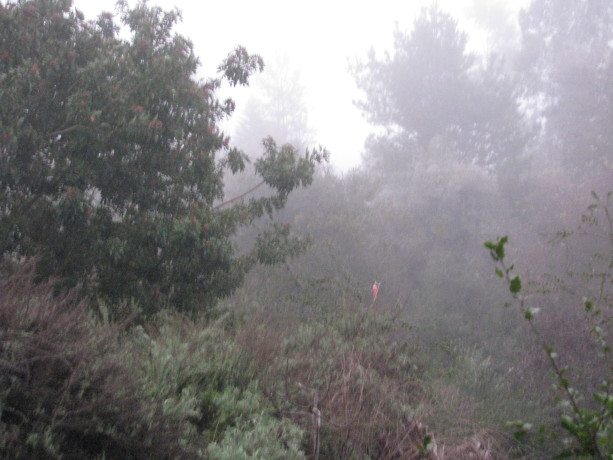 Often I’ve walked through Finch Frolic Garden of a morning to feed the hens, and the garden sounded as if it had its own special rain cloud over it. That is because moisture condenses on the leaves and rolls off. The more canopy and the higher the canopy, the more water we can collect. In that same way, canopy begins to hold humidity on the property, which the rest of the guild contributes to. Pollen dries out. With longer, hotter, drier summers there is worse pollination even if the pollinators are active, because the pollen isn’t viable. Less humidity equals fewer fruits, nuts and vegetables. Therefore, the more canopy, and other parts of a guild, the moister the air and the better the harvest.
Often I’ve walked through Finch Frolic Garden of a morning to feed the hens, and the garden sounded as if it had its own special rain cloud over it. That is because moisture condenses on the leaves and rolls off. The more canopy and the higher the canopy, the more water we can collect. In that same way, canopy begins to hold humidity on the property, which the rest of the guild contributes to. Pollen dries out. With longer, hotter, drier summers there is worse pollination even if the pollinators are active, because the pollen isn’t viable. Less humidity equals fewer fruits, nuts and vegetables. Therefore, the more canopy, and other parts of a guild, the moister the air and the better the harvest.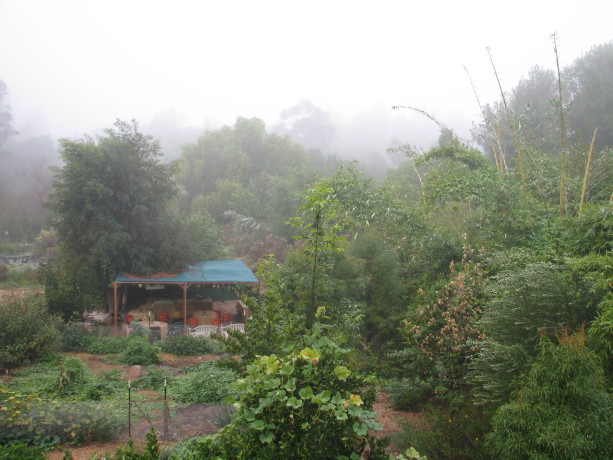
Canopy is in connection with all other plants in its community, linked via webs called mycorrhizal fungi. Through these webs the canopy sends chemical messages and nutrients to other plants. Every plant in the community benefits from the strong communications from the canopy trees.
Canopy builds soil. Canopy trees are large on top and equally large underground. Tree root growth can mirror the height and width of the above-ground part, and it can be larger. Therefore canopy trees and plants break through hard soil with their roots, opening oxygen, nutrient and moisture pathways that allow the roots of other plants passage, as well as for worms and other decomposers. As the roots die they become organic material deep in the soil – effortless hugelkultur; canopy is composting above and below the ground. Plants produce exudates through their roots – sugars, proteins and carbohydrates that attract and feed microbes. Plants change their exudates to attract and repel specific microbes, which make available different nutrients for the plant to take up. A soil sample taken in the same spot within a month’s time may be different due to the plant manipulating the microbes with exudates. Not only are these sticky substances organic materials that improve the soil, but they also help to bind loose soil together, repairing sandy soils or those of decomposed granite. The taller the canopy, the deeper and more extensive are the roots working to build break open or pull together dirt, add nutrients, feed and manage microbes, open oxygen and water channels, provide access for worms and other creatures that love to live near roots.
Canopy roots have different needs and therefore behave differently depending upon the species. Riparian plants search for water. If you have a standing water issue on your property, plant thirsty plants such as willow, fig, sycamore, elderberry or cottonwood. In nature, riparian trees help hold the rain in place, storing it in their massive trunks, blocking the current to slow flooding and erosion, spreading the water out across fields to slowly percolate into the ground, and turning the water into humidity through transpiration. The roots of thirsty plants are often invasive, so be sure they aren’t near structures, water lines, wells, septic systems or hardscape. Some canopy trees can’t survive with a lot of water, so the roots of those species won’t be destructive; they will flourish in dry and/or well-draining areas building soil and allowing water to collect underground.
In large agricultural tracts such as the Midwest and California’s Central Valley, the land is dropping dramatically as the aquifers are pumped dry. Right now in California the drop is about 2 inches a month. If the soil is sandy, it will again be able to hold rainwater, but without organic materials in the soil to keep it there the water will quickly flow away. If the soil is clay, those spaces that collapse are gone and no longer will act as aquifers… unless canopy trees are grown and allowed to age. Their root systems will again open up the ground and allow the soil to be receptive to water storage. Again, roots produce exudates, and roots swell up and die underground leaving wonderful food for beneficial fungi, microbes, worms and all those soil builders. The solution is the same for both clay and sandy soils – any soil, for that matter. Organic material needs to be established deep underground, and how best to do that than by growing trees?
In permaculture design, the largest canopy is often found in Zone 5, which is the native strip. In Zone 5 you can study what canopy provides, and use that information in the design of your garden.
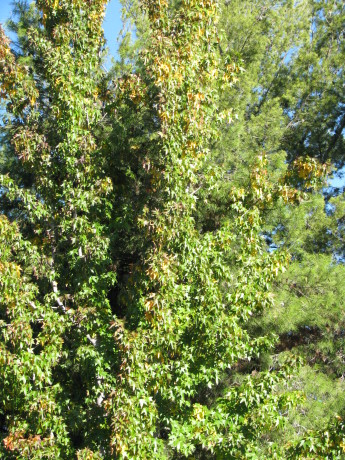 How do you achieve canopy in your garden? If your canopy is something that grows slowly, then you will need to nursery it in with a fast-growing, shorter-lived tree that can be cut and used as mulch when the desired canopy tree becomes well established. Some trees need to be sacrificial to insure the success of your target trees. For instance, we have a flame tree that was part of the original plantings of the garden. It is being shaded out by other trees and plants, and all things considered it doesn’t do enough for the garden to be occupying that space (everything in your garden should have at least three purposes). However a loquat seeded itself behind the flame tree, and the flame tree helped nursery it in. We love loquats, so the flame tree may come down and become buried mulch (hugelkultur), allowing that sunlight and nutrient load to become available for the loquat which is showing signs of stress due to lack of light. With our hotter, drier, longer summers, many fruit trees need canopy and nurse trees to help filter that intense heat and scorching sunlight. Plan your garden with canopy as the mainstay of your guild.
How do you achieve canopy in your garden? If your canopy is something that grows slowly, then you will need to nursery it in with a fast-growing, shorter-lived tree that can be cut and used as mulch when the desired canopy tree becomes well established. Some trees need to be sacrificial to insure the success of your target trees. For instance, we have a flame tree that was part of the original plantings of the garden. It is being shaded out by other trees and plants, and all things considered it doesn’t do enough for the garden to be occupying that space (everything in your garden should have at least three purposes). However a loquat seeded itself behind the flame tree, and the flame tree helped nursery it in. We love loquats, so the flame tree may come down and become buried mulch (hugelkultur), allowing that sunlight and nutrient load to become available for the loquat which is showing signs of stress due to lack of light. With our hotter, drier, longer summers, many fruit trees need canopy and nurse trees to help filter that intense heat and scorching sunlight. Plan your garden with canopy as the mainstay of your guild.Therefore a canopy plant isn’t in stasis. It is working above and below ground constantly repairing and improving. By planting canopy – especially canopy that is native to your area – you are installing a worker that is improving the earth, the air, the water, the diversity of wildlife and the success of your harvest.
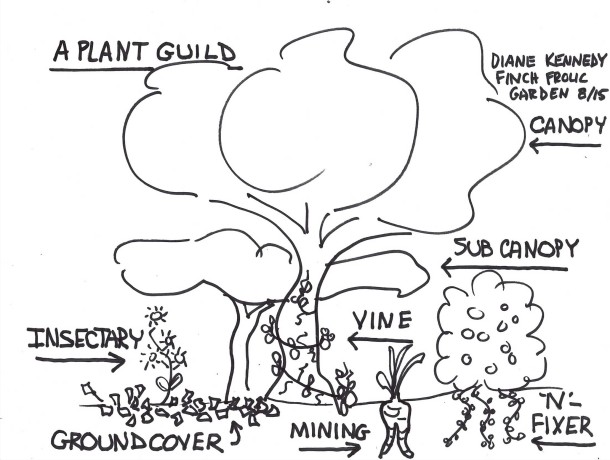
What makes up a plant guild. Canopy is improving the water storage of the soil and increasing potential for aquifers. The more site-appropriate, native canopy we can provide in Zone 5, and the more useful a canopy tree as the center of a food guild, the better off everything is. All canopy asks for in payment is mulch to get it started.
Next week we’ll explore sub-canopy! Stay tuned! You can find the entire 9-part Plant Guild series here: Plant Guilds: What are they and how do they work? The first in a series. , Plant Guild #3: Sub-Canopy , Plant Guild #4: Nitrogen-Fixers, Plant Guild #5: Mining Plants, Plant Guild #6: Groundcovers, Plant Guild #7: Vines, Plant Guild #8: Insectiaries, Plant Guild #9: The Whole Picture.
- Animals, Bees, Birding, Compost, Fungus and Mushrooms, Gardening adventures, Health, Hugelkultur, Microbes and Fungi, Natives, Other Insects, Permaculture and Edible Forest Gardening Adventures, Pets, Rain Catching, Seeds, Soil, Water, Water Saving, Worms
Lawn Care and Lawn Alternatives for Drylands
Drought restrictions have caused many people to turn the water off of their lawns; many have already taken that leap years ago. One of the main questions I field now is what to do with that nasty patch that once was a lawn. There are many low-water-use alternatives.
First, please don’t use artificial turf or gravel. Read about why by following the links to past blogposts.
You can have a lawn and not use as much water, and not add any chemicals to it, by understanding how grass grows. You can starting learning everything about lawn caring at ngturf.com/area-calculator/.
If you want and/or need a lawn space, make it as minimal as possible. If you are going to reseed, choose a California native seed that withstands the drought and our alkaline soil. Creeping red fescue is a good choice that grows tall and floppy unmowed, but is a walkable/playable lawn if mowed.
A grass plant spreads at its base, not its tip. Grass needs its blades to produce food. Common mowing techniques recommend mowing low, but that is doing your lawn harm and resulting in the need for aeration and chemical fertilizers. When you mow low, the stressed grass plant needs to push lots of energy into quickly growing more blades to feed its roots. Most weeds have a growing point at their tip and with a strong weed killer it can be stopped. Mow as high as your mower allows – 4 inches if possible. High mowing allows the grass plant to keep its blades for food making, and to put energy into deep root growth and into spreading. Mowing high cuts the tops off the weeds, and the height of the grass shades out weed seeds so they can’t germinate.
Water deeply, and less frequently. Catch an inch of water in a cup set under your lawn irrigation and shut the water off. Don’t water again until the grass shows that it needs it. Constant irrigation, especially on short grass where the soil is exposed, and rainwater on bare earth is as compacting as running a tractor over the ground. When the earth is compacted water just won’t penetrate. You pour water onto the grass which runs off or evaporates. Your grass can’t grow deep tap roots and is slowly starved to death.
Use a mulching mower and allow the grass clippings to return to the lawn. Stop using chemical fertilizers. Completely. In permaculture we feed the soil and not the plants. Healthy soil has billions of fungi, bacteria, nematodes, amoebas, and other creatures in every teaspoon. This zoo of soft-bodied creatures break down organic matter and make nutrients in the soil available for roots to feed from. The better the soil health, which means the more microbial activity and population, the loamier the soil and therefore the better water penetration as well. Instead of dumping high nitrogen fertilizer on your lawn, use compost, actively aerated compost tea , and chopped up leaves. (If you don’t have a mulcher attachment on your mower, or a blower with a reverse vacuum attachment, then put leaves in a trash can and use a string mower to chop them up- while wearing eye protection of course!). Chopped up leaves are all you need to fertilize anything. Best of all they don’t harm your pets or family, unlike chemical fertilizers.
If you don’t want a lawn, then figure out how you want to use the space. Do you want to just see the area from your windows? Do you want a meditation garden? Room for kids and pets to play? An outside BBQ spot? Decide how best to use this space. If you aren’t using every square inch of your property, you are paying property taxes for nothing.
To get rid of your lawn you don’t need to dig it up. Please save your money. Sheet mulch it. Sheet mulch is an inch of cardboard and/or newspaper topped with 4-6 inches of mulch. Gorilla hair (shredded redwood) or shredded ceder bark spread well and sit lightly on the soil, and you get more for your money. Sheet mulch will turn the grass into mulch and start activating the soil. Best of all, it looks instantly great, to satisfy your neighbors and family. If you have Bermuda or other very determined grass, you may need a thicker layer of cardboard. Sheet mulch now and allow it to sit over the winter and absorb the rains. In the spring you can cut through the cardboard and plant right in the ground.
If you want a low-effort garden, then please go native. We need to replace habitat that has been destroyed and give the animals and insects the food and shelter that they need to survive. Many California native gardens are not well done and look piecemeal and stark. This doesn’t have to be. Look around at the hills; unless you are well into the desert, there are plants of all types everywhere. If you have sheet mulched a green lawn, then allow the grass to die completely before planting natives; they don’t like higher nitrogen from freshly decomposing grass, or the residual from high nitrogen fertilizer. Sheet mulching over the winter and planting in the spring should be fine. If your lawn is already dead, then you can sheet mulch and plant immediately. Then allow the plants to fill out and you don’t need to mulch again.
See how the area looks from your windows. Make pathways that are wide enough to accommodate whomever is going to use it (2 feet wide for one person, 3 feet for two or a bicycle, 4 feet for a wheelchair). Don’t skimp on the pathway material. An ugly or uneven pathway will draw all your attention and no matter what you do around it, it will look bad. A good pathway well done and complementary to your house is important for your own satisfaction and for the resale value of your home as well. Choose destination spots and focal points. Benches, a bird bath, a specimen plant – these are all important. Then choose plants. I highly recommend the book California Native Landscapes by Greg Rubin and Lucy Warren. These are San Diegans so they know what works well in Southern California.
One inch of rain on one acre in one hour is 27,154 gallons of free, neutral pH rainwater. Most lawns are slightly convex so that water runs off of them. That is why there is a bald spot at the highest point where you just can’t keep anything alive. You want to catch all the rainwater -and irrigation water – you can. Catch it, sink it, spread it. Do this with simple earthworks that you can do with a shovel. Perpendicular to the water flow dig shallow swales (level-bottomed ditches). They only need to be an inch deep, or you can go much deeper. They can be filled with large mulch, and sheet-mulched over the top. Rain will then sink into the ground rather than rolling off. Sheet mulch – or any mulch – allows the rain to hit, bounce and then gently fall to earth. Catch every drop that you can, and the best place to catch rain is in your soil.
To further add water retention and nutrition for your microbes, bury wood. Old logs, old untreated building materials (nails and all), shrub cuttings, nasty spiky rose cuttings, palm fronds and trunks, they can all be buried and planted over in a process called hugelkultur. Even old cotton clothing, straw hats, or anything made with natural fibers can be layered with dirt and buried. Get the most from what you’ve already spent money on and let your trash fix your soil.
So, steps would be to decide what you want to do with your lawn area, design the pathways and special areas, determine what kind of plants you want to put there, dig in some earthworks, sheet mulch to kill the grass and weeds, then plant. Natives will need supplemental water (not drip irrigation, but a long soak and then allowed to go dry) until they are established. Then many of them don’t want any supplemental water; some go drought-deciduous, so do your research. A good selection that is lovely and will invite birds and butterflies into your yard might include Cleveland sage (not Mexican bush sage, which becomes very woody), apricot mallow, desert mallow, fairy duster, and ceanothus. Great retail native nurseries are Theodore Payne nursery in Los Angeles and Tree of Life nursery in San Juan Capistrano.
If you don’t want to go native, then consider low-water-use plants such as many Mediterranean herbs. Rosemary, oregano, marjoram, lavender and others interspersed with drought tolerant plants such as bird of paradise, New Zealand flax, rockrose, Pride of Madeira, and a host of interesting succulents in between. Aloe blooms are attractive to hummingbirds.
If you live in areas where there is a real winter, where you receive snowfall, your lawn care to prepare for the cold is quite different. The folks at Yardday have excellent tips to help prepare for snow, and you can read about them here. Keep in mind that the ‘fertilizer’ should be actively aerated compost tea and/or compost, NOT bagged NPK or other chemical or condensed lawn care fertilizer. These concentrated fertilizers kill microbes leaving your soil lifeless, water-repelling dirt.
There are lots of things to do with your lawn that are lovely, useful, interesting and beneficial to wildlife and to the earth. Care for your soil by not poisoning the microbes with chemicals, use your leaves, sheet mulch, and design for low water use. Its worth the effort.
- Animals, Bees, Birding, Compost, Gardening adventures, Health, Microbes and Fungi, Natives, Other Insects, Pets, Ponds, Predators, Quail, Rain Catching, Reptiles and Amphibians, Soil, Water, Water Saving, Worms
Why Buy Rain Barrels if you Own a Pool? Pool Conversion Discount!
Why buy rain barrels if you own a pool? You can collect about 20,000 gallons of rainwater in an average pool, and use it on your landscaping and for swimming if you don’t chlorinate it. If you have a pool or pond and put chemicals into it, or have a saltwater pool or one that is treated with UV light, you really need to read about how toxic those systems really are and how to change your pool into a swimmable, clean pond on PuraVidaAquatic.com. On that site is a host of great information about how bad mosquito fish are, how to make a truly healthy pond, why having a pond in a drought is a great idea and so very important, and so much more. If you live in Southern California and have a pool, you’ll be interested in this Fall Special:
- Animals, Bees, Birding, Compost, Fungus and Mushrooms, Gardening adventures, Health, Heirloom Plants, Microbes and Fungi, Natives, Other Insects, Perennial vegetables, Permaculture and Edible Forest Gardening Adventures, Pets, Ponds, Predators, Quail, Reptiles and Amphibians, Water, Water Saving, Worms
Permaculture and Pollinators lecture
- Animals, Bees, Birding, Compost, Fungus and Mushrooms, Gardening adventures, Health, Heirloom Plants, Houses, Hugelkultur, Microbes and Fungi, Natives, Other Insects, Perennial vegetables, Permaculture and Edible Forest Gardening Adventures, Ponds, Predators, Quail, Rain Catching, Recycling and Repurposing, Reptiles and Amphibians, Soil, Vegetables, Water, Water Saving, Worms
My Plea Against Gravel
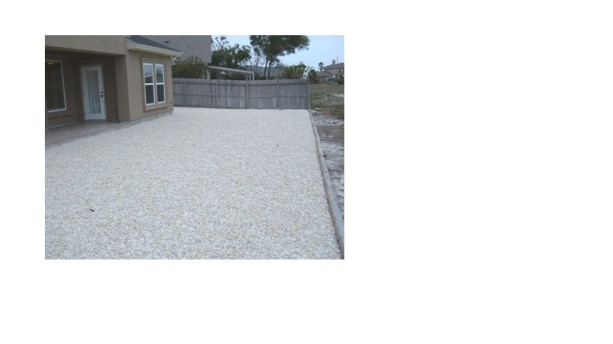 Here in Southern California, as in many other areas, we are finally legally recognizing the drought. There are rebates in place for those who take out their lawns, and here in Fallbrook there is a 36% water reduction goal. Many people just don’t know what to do with all that lawn. A very unfortunate continuing trend is to dump half a ton of colored gravel on it. Please! NO! First of all, once down gravel is nearly impossible to get out again. Gravel, like all rocks, is thermal mass. Instead of having a large rock heating up and radiating out heat, with gravel there are tens of thousands of surfaces radiating out heat and reflecting light and heat back up. It is the worst kind of hardscape. All that reflected heat and light heats up your home, making you use your air conditioner more frequently which is a waste of energy, and also dries out the air around your home. Desertification reflects light and heat to a point where moist air moving over a region dries up. There is less rain, or no rain. Most trees and plants trap humidity under their leaves. Gravel reflects light and heat back up under those leaves and dries them out, sickening your plants and trees. Pollen travels farther on humid air; it can dry out quickly. If you are relying on pollination for good fruit set between trees that are spaced far apart, then having some humidity will increase your chances of success.
Here in Southern California, as in many other areas, we are finally legally recognizing the drought. There are rebates in place for those who take out their lawns, and here in Fallbrook there is a 36% water reduction goal. Many people just don’t know what to do with all that lawn. A very unfortunate continuing trend is to dump half a ton of colored gravel on it. Please! NO! First of all, once down gravel is nearly impossible to get out again. Gravel, like all rocks, is thermal mass. Instead of having a large rock heating up and radiating out heat, with gravel there are tens of thousands of surfaces radiating out heat and reflecting light and heat back up. It is the worst kind of hardscape. All that reflected heat and light heats up your home, making you use your air conditioner more frequently which is a waste of energy, and also dries out the air around your home. Desertification reflects light and heat to a point where moist air moving over a region dries up. There is less rain, or no rain. Most trees and plants trap humidity under their leaves. Gravel reflects light and heat back up under those leaves and dries them out, sickening your plants and trees. Pollen travels farther on humid air; it can dry out quickly. If you are relying on pollination for good fruit set between trees that are spaced far apart, then having some humidity will increase your chances of success.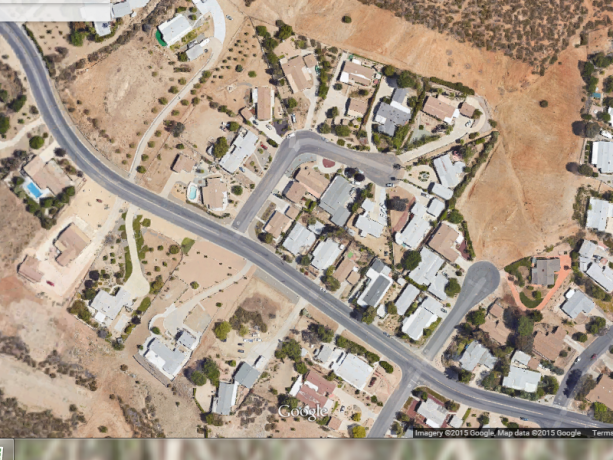
An area of Wildomar, surrounded by hillsides of chaparral that hasn’t been destroyed. These homes have mostly gravel yards and denuded, compacted backyards. Very little rain penetrates, and all the weeds that nature sends it to help repair this gash in the earth are promptly poisoned. This is death to us and our planet. By laying gravel you are turning soil into rock-hard dirt, because microbial life cannot live closely under it. That robs any plants you have stuck into the gravel of the food they need from the soil, which is opened up through microbial activity. You are adding to the heat value of the hardscape around your house causing you to cook in the summer and use more air conditioning. You have reduced habitat to zero. You have added to global warming by reflecting more heat and light into the sky. Although gravel is permeable, usually the ground below it bakes so hard that rain doesn’t percolate. I’ve read sites that want to you increase the albedo effect by laying gravel. In the short term albedo helps cool the atmosphere, but as a result of too much reflected light dries everything out. Think of the dark coolness and dampness of forests… that are now bare ground.
What do you do with your lawn instead? There are many choices that are so much better for the earth and your quality of life. First step, cut swales on contour on any slopes for best rain harvesting. Flat lawn? Easier still. Turn your lawn into a beautifully landscaped lush native garden. I’m not talking about a cactus here and there, but a creation with the awesome native plants we have in Southern California. Some of them such as Fremontia can die with supplemental summer water!

A beautiful border and plantings of California natives. Very low water use here, and very high habitat! There is a chocolate daisy that smells like chocolate. Oh yes. And how can you not want to plant something called Fairy Duster or Blue-Eyed Grass? A native landscape planted on soil that has been contoured to best catch and hold water, and amended with buried wet wood (hugelkultur), will give much-needed food, water and breeding grounds to countless birds, butterflies, native insects and honeybees.
Or put in a pond. Wait, a pond during a drought? Yes! Ninety-nine percent of California wetlands have been paved over, drained or are unusable. Where are all the animals drinking? Oh, wait, we are in the epicenter of extinction, mostly due to wetlands loss. There are very few animals left that need to drink. Those that are left have to take advantage of chlorinated water in bird baths and swimming pools. The microbially rich and diverse clean, natural water that fed and sustained life is just about gone. So what can you do? If you have a swimming pool, you can convert it either entirely to a pond, or into a natural swimming pool that is cleaned by plants.
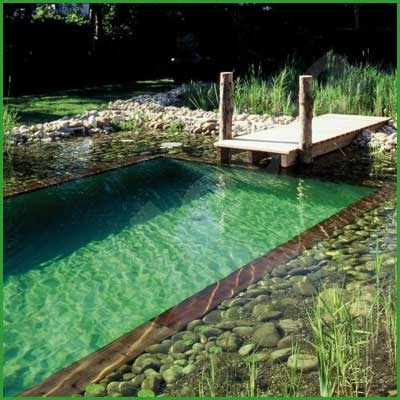
A natural pool upgrades your pool to a lovely pond without the use of chemicals. Suddenly instead of having this expensive eyesore that you use only a couple of months a year and pour chemicals into year-round, you have a lovely habitat that you want to sit and watch, and even better, swim in safely without turning your hair green or peeling your skin. You don’t need to clean the pool all the time, and you don’t need to put in chemicals. If you are in the San Diego or Los Angeles area, call Dr. Robert Lloyd of PuraVida Aquatics for a consultation and conversion. If you don’t have a pool, then build one that is cleaned by plants and fish. You don’t need a filtration or oxygenation system because the biology does it all. Where do you get the water from to top off your pond?
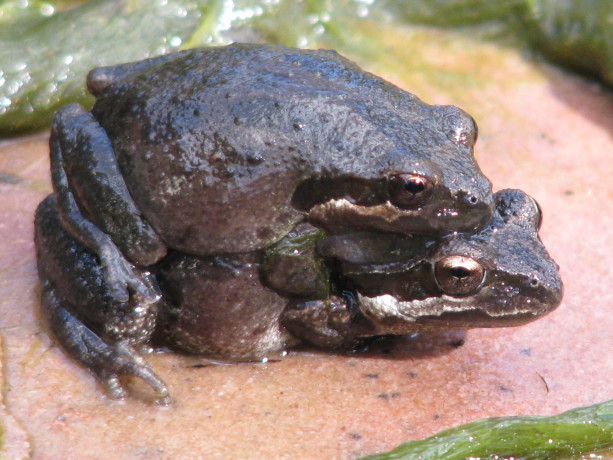
Native Pacific Chorus Frogs enjoying our clean pond at Finch Frolic Garden. Connect your pond to a lovely, planted stream that is connected to your laundry water or graywater system. You are buying water every day, so why not compost your water through phytoremediation and have a pond full of great healthy chemical-free water that is wonderful to look at and is an oasis for thirsty animals and insects?
Or install a food forest. With good soil building and rain catchment first, and planting in guilds with sheet mulch around trees and on pathways, you will be using a fraction of the water you pour on your lawn and yet harvest lots of food. Too much food? Share it with a food pantry!
Or start a veggie garden without digging any sod.

Create a lasagna garden right on top of the lawn and start growing immediately. Layer cardboard, sticks, grass, food scraps, leaves, more grass, more food scraps, more leaves and top it with about 8 inches of good soil, then plant right in it! That lovely standing compost heap will slowly turn into good soil while killing the grass beneath and growing crops for you immediately.
If ridding yourself of a lawn just breaks your heart, then substitute the high-water use grasses for a native grass mix that is comparable. Look at S&S Seeds for prices or for seed choices. Water a few times with Actively Aerated Compost Tea using any rainwater you may have caught in those 50-gallon containers and your grass roots will travel so deeply that they will find groundwater. Check up on the work of soil microbiologist Dr. Elaine Ingham and see how easy AACT is to make and use.
There are so many alternatives to using gravel that aren’t expensive, that are an investment in your property and in reclaiming habitat while beautifying your home and saving money. So please, just say, “NO,” to the gravel. Tell a friend!!
Which one of these would you rather live in? Which do you think is better for the earth and for the future generations?

Finch Frolic Garden, year 3. - Animals, Bees, Birding, Building and Landscaping, Chickens, Compost, Fungus and Mushrooms, Gardening adventures, Hugelkultur, Microbes and Fungi, Natives, Natural cleaners, Other Insects, Permaculture and Edible Forest Gardening Adventures, Pets, Ponds, Predators, Quail, Rain Catching, Reptiles and Amphibians, Water Saving, Worms
Saving the Bees

The ponds at Finch Frolic Garden are cleaned by fish and plants, with no chemicals, algaecide, artificial aeration or filtration. Well-balanced water allows wildlife to thrive. I should have more accurately called this post, Saving All the Insects, or even Saving the Wildlife, because the answer to saving one is the answer to saving them all. We’ve been inundated for years – my whole lifetime, in fact, – with pleas to save our environment, stop whale slaughter, stop polluting, etc. I remember winning a poster contest in fifth grade on the subject of curtailing littering. Since Rachel Carson’s books woke people up to the hazards of DDT and how chemicals have many deadly side effects there has been a grassroots effort to stop the pollution. Since Al Gore’s An Inconvenient Truth came out the push for environmentally friendly lights, cars, LEED-certified buildings and many more positive anti-climate-change actions have grown furiously. Too bad no one listened to him decades before. A drop in the economy and the radical change in weather patterns have people exploring organics, making their own clothes and foods, changing their shopping habits and thinking about what they are bringing into their homes. However, this week the World Wildlife Fund released the staggering results of a study that states that between the years 1970 and 2010, 52% of the world’s animal populations are gone. Over half. Gone. On our watch. In my lifetime. I am stunned with shame. So what about the next 40 years? Over 97% of California wetlands are already gone. There are only 3% left in Los Angeles. The Colorado River hasn’t met the ocean for decades, except briefly last year due to major earthworks. We are pumping all that water overland, open to the sun for evaporation, to treatment plants that fill it with chlorine and other chemicals, then sell it to us to spray over lawns and flush down the toilet or let run down the drain while the water heats up. It is madness. All the wildlife that depended upon the Colorado River along that stretch are gone. All the insects, the frogs, lizards, birds, mammals, etc. that need a clean drink of water no longer have access to it. The only water they can drink is usually chlorinated domestic water in ponds and bird baths. Too often this water is treated with algaecide, which claims it doesn’t hurt frogs but it does kill what the frogs feed upon. We are killing our animals with poisoned domestic water.
![dry_colorado_new[1]](http://www.vegetariat.com/wp-content/uploads/2014/10/dry_colorado_new1-613x321.jpg)
One of the largest reasons we have extinctions in North America is mismanagement of rainwater in drylands (other than polluting the waters. Poaching, over-fishing, destruction of habitat and climate change are the main reasons). We have cleared and flattened the ground, and channel rainwater off into the ocean. Look around at your streets and houses. Are they harvesting water or channeling it? Any property that is slanted is channeling water away. Any property that is level – like the bottom of swales – is harvesting water. So many properties are inundated with annual rains because there is no water harvesting above them. When you harvest water, it runs into rain catchment basins and swales instead of roaring down the hillside taking all the topsoil with it. Water becomes passive and percolates down deeply into the soil. That deep saturation draws tree roots down into the ground. The roots break up hardpan, make oxygen and nutrient channels into the dirt and produce exudates (sugars, carbohydrates and starches) through their roots to attract and feed the billions of microbes that turn your dirt into rain-holding soil. That underground plume of rainwater then slowly passes through your soil, re-enervating subterranean waterways, refilling your wells and bringing long-dry streambeds back to life. We must harvest rainwater to save our animals and plants, and consequently ourselves. We must reestablish sources of clean, unpolluted chemical-free water for animals to eat and from which to drink.
Healthy pond water is off-color due to tannins, and is filled with tiny creatures. Some such as daphnia are visible, but just like soil microbes, many aquatic creatures are microscopic. Fish and frogs feast from this level of the food chain, and these creatures make the water balanced. They eat mosquito eggs. They clean up algae. They are as vitally important as soil microbes. Oh, and 83% of the frogs are gone.
I spoke with Quentin Alexander from HiveSavers today; he performs humane bee rescue around the San Diego area and has been trying to re-queen Africanized hives with calmer European queens which will breed nicer behavior back into the bees rather than having to kill the entire hive. He has had no luck in the past two years with European queens, even those bred in California. With very little wetlands left, and those often sprayed with DEET by Vector Control, or polluted with chemical fertilizers and oils washed out of front yards, streets and driveways, these insects must resort to drinking from swimming pools and bird baths. Again, these contain highly chlorinated water. Animals are being forced to drink poison, or not drink at all.
We MUST stop using chemicals on our properties, and we MUST harvest rainwater. We MUST stop spraying well water into the air but irrigate with it in dripper form under mulch so that it is cycled back into the ground rather than evaporated. One inch of rain on one acre in one hour is 27,154 gallons of water! It is so easy to harvest rainwater – dig level-bottomed swales! Dig small ones with a trowel. Fire up the tractor and turn road ways into swales, or cross-cut vertical paths with swales that have dedicated overflows. Dig rain catchment basins to catch a flow of water. Catch water as high up on your property as you can. If you have level soil, fantastic! You have it so easy!
Make gentle swales, rain gardens, rain catchment areas and sunken gardens to catch and percolate the water. Bury old wood perpendicular to water flow – its called hugelkultur.
Please watch this six-minute video by Geoff Lawton of the Permaculture Design Institute of Australia. You need to type in your name and email, but they don’t sell your information nor do they bug you with lots of emails. Here is the link. The title is Finding An Oasis in the American Desert, and it is about the Roosevelt swales dug during the dust bowl in the desert. If nothing that I say, nor anyone else says can convince you, then please watch this and see the effectiveness of rain harvesting. We MUST do this, and now before the rains come is the time. Catch all the water that falls on your property in the soil, and try to catch the water that runs into it. If there are flood waters channeled through your property, see if you can talk to the people who own land above you about harvesting water up there. It will reduce the flooding, save topsoil and benefit everyone’s property. Work towards keeping rainwater in your soil, reducing your domestic water, and making what streambeds are left come back to life. Keep our old trees from dying by watering deeply through rain catchment. If you have a pond or swimming pool and treat it with harsh chemicals and algaecides, seek out a natural pond professional. In the San Diego – Los Angeles region there is Bob Lloyd of PuraVida Aquatics, or Jacob Hatch of Hatch Aquatics. Jacob builds natural ponds and maintains large natural waterways. Bob maintains chemical-free backyard and display ponds that are full of wildlife. He can convert your pool into a clean swimming pond where the water is filtered by plants and thus is lovely year-round, provides abundant habitat and doesn’t need chemical treatments. No chlorine to burn your skin and eyes. How great is that? He can also create a constructed wetland that cleans your greywater with plants.
There are so many simple and inexpensive ways to harvest rainwater rather than allow it to flow into the salty ocean without penetrating the soil. Please, please, please do them, and if you already have THANK YOU and gently encourage your neighbors to do the same. We must stop the habitat destruction and start to rebuild what is gone.
- Animals, Bees, Birding, Building and Landscaping, Chickens, Cob, Compost, Composting toilet, Fungus and Mushrooms, Gardening adventures, Giving, Health, Heirloom Plants, Hiking, Houses, Hugelkultur, Humor, Living structures, Natives, Natural cleaners, Other Insects, Permaculture and Edible Forest Gardening Adventures, Pets, Photos, Predators, Quail, Rain Catching, Recycling and Repurposing, Reptiles and Amphibians, Seeds, Soil, Vegetables, Water Saving, Worms
Special Tours for Aug. and Sept., 2014
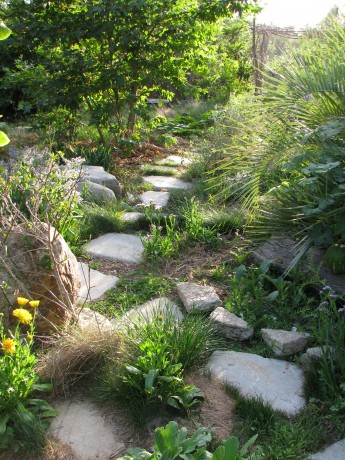
Come take a tour of a food forest! Normally tours of Finch Frolic Garden are held by appointment for groups of 5 – 15 people, Thursdays – Mondays. Cost is $10 per person and the tour lasts about two hours. By popular demand, for those who don’t have a group of five or more, we will be hosting Open Tour days for the first 15 people to sign up in August and September. They will be Sunday, August 10 and 24, Sept. 7 and 21, and Thursdays August 7 and 28, and Sept. 11 and 25. Tours begin promptly at 10 am. The tours last about two hours and are classes on basic permaculture while we tour the food forest. I ask $10 per person. Please reserve and receive directions through dianeckennedy@prodigy.net. Children under 10 are free; please, no pets. Photos but no video are allowed. Thank you for coming to visit! Diane and Miranda
- Animals, Bees, Birding, Books, Building and Landscaping, Chickens, Cob, Compost, Composting toilet, Fungus and Mushrooms, Gardening adventures, Heirloom Plants, Hugelkultur, Humor, Living structures, Natives, Natural cleaners, Other Insects, Permaculture and Edible Forest Gardening Adventures, Ponds, Predators, Quail, Rain Catching, Recycling and Repurposing, Reptiles and Amphibians, Seeds, Soil, Water Saving, Worms
Permaculture Lectures At Finch Frolic Garden, June 2014
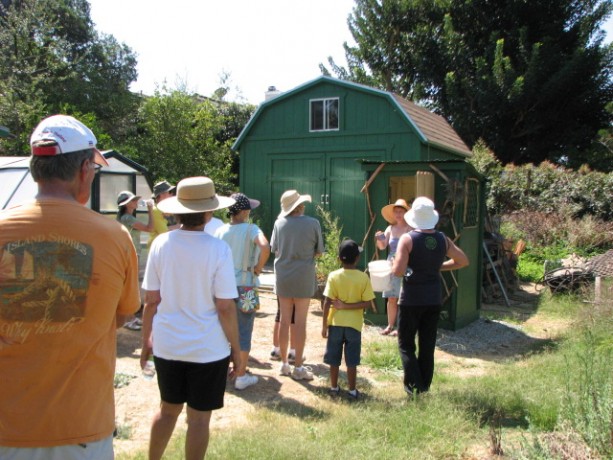
Tour Finch Frolic Garden! Permaculture Lectures in the Garden!
Learn how to work with nature and save money too
Finch Frolic Garden and Hatch Aquatics will present four fantastic, information-filled lectures in June. Join us at beautiful Finch Frolic Garden in Fallbrook, 4 pm to 6 pm, for refreshments and talks on…
Saturday, June 7: Introduction to Permaculture and Finch Frolic Tour: We’ll take you through the main precepts of permaculture and how it can be applied not only to your garden, but to yourself and your community. Then we’ll tour Finch Frolic Garden and show rain catchments, swales, plant guilds, polyculture, living buildings and so much more.
Saturday, June 14: Your Workers in the Soil and Earthworks: Learn the best methods for storing water in the soil and how to replace all your chemicals with actively aerated compost tea and compost.
Saturday, June 21: Aquaculture: You can have a natural pond – even in a tub! How natural ponds work, which plants clean water and which are good to eat. Even if you don’t want a pond, you’ll learn exciting information about bioremediation and riparian habitat.
Saturday, June 28: Wildlife in your Garden: What are all those bugs and critters and what they are doing in your yard? We’ll discuss how to live with wildlife and the best ways to attract beneficial species.
Your hosts and lecturers will be
Jacob Hatch Owner of Hatch Aquatics. With years of installing and maintaining natural ponds and waterways, and a Permaculture Design Course graduate, Jacob has installed earthworks with some of the biggest names in permaculture.
Miranda Kennedy OSU graduate of Wildlife Conservation and wildlife consultant, Miranda photographs and identifies flora and fauna and maps their roles in backyard ecosystems.
Diane Kennedy Owner of Finch Frolic Garden, lecturer, consultant, Permaculture Design Course graduate, former SDC Senior Park Ranger, Diane educates homeowners on how to save money and the environment while building their dream gardens.
Each class limit is 50 attendees, so please make pre-paid reservations soon before they fill up. Fee for set of four lectures and tour is $45 per person. Single session fee is $20 per person. Contact Diane Kennedy at dianeckennedy@prodigy.net for reservations and directions.
You will not want to miss this fascinating and useful information!

